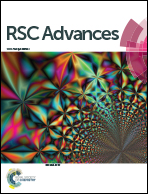Synthesis of europium-doped ZnS nano-crystalline thin films with strong blue photoluminescence†
Abstract
Eu2+-Doped ZnS (ZnS:Eu2+) thin (∼550 nm) films with strong and stable blue photoluminescence have been successfully synthesized by a simple and fast ultrasonic spray pyrolysis method. According to X-ray diffraction (XRD) and high resolution scanning electron microscopy (SEM) analysis, the as grown ZnS:Eu2+ films are composed of hexagonal wurtzite nanocrystals with average size of ∼25 nm, which are preferentially oriented along the (002) direction and agglomerate to form hexagonal facet nanobars with diameters from 50 to 200 nm. These films show a strong blue emission centered at 454 nm, which can be observed with the naked eye under ambient illumination. The intensity of this peak is ∼185 times higher than the maximum photoluminescence peak observed from the undoped ZnS films. The presence of the Eu dopant in the valence state Eu2+ was confirmed by electron spin resonance (ESR) measurements. The comparison of the high-resolution UV-vis absorption spectra and the PL characteristics of the ZnS:Eu2+ films with the pure ZnS films, indicate that the strong blue emission of the ZnS:Eu2+ films comes from Eu2+ 4f65d → 4f7 intra-ion transitions.


 Please wait while we load your content...
Please wait while we load your content...